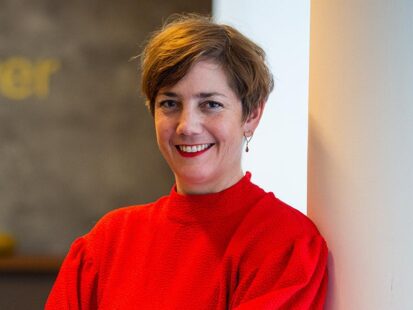
Walburga Hemetsberger believes more needs to be done to drive momentum on solar’s spectacular European growth. Julia Kramer finds out more.
Walburga Hemetsberger doesn’t just like solar. She loves it. The chief executive of SolarPower Europe — a Brussels-based association with more than 300 members representing the solar value chain — is passionate about solar because of the versatility of the technology and the fact you can install it everywhere.
“There is this kindergarten in Portugal that is using its full roof for solar, and they share the surplus electricity with the neighbourhood, specifically with some families that are having difficulties making ends meet every month. “These are beautiful stories that you are following when you are in the solar sector, and this is super encouraging,” says Hemetsberger with a smile on her face, clearly appreciating the purpose behind the technology.
In addition, she finds it encouraging that solar’s popularity is growing. It is cheaper than ever, and “is now seen as being at the centre of the green transition”. Speaking to Hemetsberger in Brussels, it seems obvious that any CEO representing a renewable energy association would argue that their technology is at the heart of the energy transition, however, there is no doubt that the data backs Hemetsberger’s statement.
Have you read?
Time for the solar workforce to shine
Watch this space: solar power boldly goes into new niche
According to SolarPower Europe’s latest Global Market Outlook, solar PV accounted for two-thirds of all new renewable power capacity installed in 2022. It achieved the highest growth rate in terms of electricity generation across any power generation technology. Globally, 239GW of new solar capacity was connected to the grid last year: a 45% increase from 2021.
In Europe, over 40GW of solar was installed, which was 11GW more than SolarPower Europe had forecast in their medium scenario in 2021. This growth doesn’t surprise Hemetsberger. When she became the CEO of SolarPower Europe in 2019 after having worked for Austrian energy company Verbund and being a board member of Hydrogen Europe, she anticipated the growth of the solar sector. “But we keep surprising ourselves with our figures. When I came in, at the time when we did our forecasts, people were smiling at us, and telling us that we were overestimating our forecasts.”
That has changed.
“Now people start realising that it is not just wishful thinking that we are promoting, but that it is the forecast of how we see the market developing. Year on year, we are outperforming our forecasts.”
According to Hemetsberger, political will is one of the key reasons for the growth of the solar sector in the past European growth. “These are beautiful stories that you are following when you are in the solar few years. She mentions the European Green Deal policy framework as a key growth of the solar sector in the past few years.
She mentions the European Green Deal policy framework as a key enabler for this growth trajectory and considers REPowerEU as another step in the right direction. “Unfortunately, we learned the hard way that we were very dependent on fossil fuels, but we have now finally realised that we need to go much faster on renewables, this has spurred the whole renewable rollout.”
Challenges for solar in Europe
Hemetsberger is happy with the latest market figures, but she also emphasises that it comes with some realism and humility. “We still foresee huge growth, but there are also huge challenges coming up. We cannot be complacent. We need to work very hard to get the hurdles out of the way.” Zooming in on the hurdles, she says she is picturing a solar powerhouse that has five main building blocks:
- Regulatory stability: “This is the basis everywhere;”
- Future-proofed grids;
- Sufficient skills: “We need to scale-up and attract people from declining industries;”
- Faster permitting: “It’s not as bad as the wind sector, but there are some countries where it can take up to four years;”
- And green and sustainable supply chains: “We need to make sure that our customers [trust] us when they’re buying solar products and can trace where they come from”.
The last challenge seems to be the most pressing. The association is currently working on a Solar Stewardship Initiative to address the traceability issue. That seems, however, the easiest part of the supply chain issue to solve. Ensuring EU manufacturers play a significant role in the globalised solar supply chain is vital, as China’s dominance as the sector’s world leader continues.
Hemetsberger likes to think about this as a ‘rewarding challenge to solve’, rather than as a headache. “I truly believe we need to also have some resilience in our sector and have manufacturing across the whole supply chain in a sizable way in Europe. “There is a price crisis in the solar supply chain right now, and we have effective solutions at the ready. The European Commission can adjust state aid rules; we could very quickly set up an EU Solar Manufacturing Bank, and we can land ‘resilience’ auctions.
“We’ve learned from history that trade barriers are not the solution. They have unintended consequences, and we can’t risk the rapid roll-out of solar in Europe,” she says.
This is, therefore, a core focus of the association, because she believes this vision has the greatest chance of success when all members work together. “There is no question if we want to or if we do not want to. We have to. We need to make sure that this transition is happening.”
“We need to have manufacturing across the whole supply chain in a sizable way in Europe”
Walburga Hemetsberger, CEO of SolarPower Europe
Supply chain
Hemetsberger not only makes this argument because of energy security. She is also referring to the positive reception solar is currently experiencing. “Solar is highly accepted. Latest studies show that 85% of Europeans fully support solar, which is great. But I believe that also from a manufacturing and industry side, we need to add value in Europe, if we want to have the full support of European citizens and politicians and make this green transition a success.”
So how do we do that? Hemetsberger believes it will be important to, “scale up quickly and that means competitive financing in the long run.”
Additionally, it will be important to “incentivise demand for European products;” and she considers the EU’s Net Zero Industry Act to be a good start. Lastly, she believes Europe still has a competitive advantage when it comes to sustainability in terms of recyclability and human rights. “That is a card we have to play in Europe.” But the clock is ticking. Hemetsberger believes there is only a “small window of opportunity” to use this advantage because “the world is not standing still”.
The US Inflation Reduction Act (IRA) is probably one of the clearest illustrations that the market can change quickly. Hemetsberger acknowledges that the IRA has brought huge competition for Europe, however, she believes that it should rather be seen as an encouragement to do something similar, rather than as a threat. Europe is still discussing framework conditions, and what it can put on the table.
However, when pressed on the “small window of opportunity,” she admits that there is “no year” to finalise these European policies. “It needs to be fast. And yes, it should have come before the IRA, because these investments would have taken place at a time when we were in a really good space in Europe. So yes, it should have happened earlier — but I know we are not in a lost battle.




